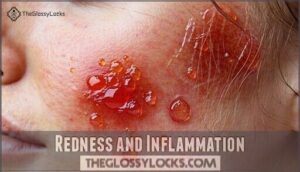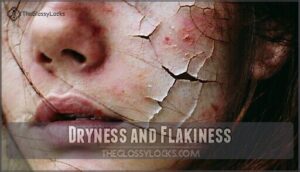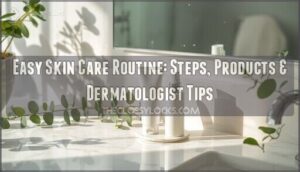This site is supported by our readers. We may earn a commission, at no cost to you, if you purchase through links.
 Your sensitive skin isn’t throwing tantrums for no reason – it’s responding to real threats lurking in your daily routine.
Your sensitive skin isn’t throwing tantrums for no reason – it’s responding to real threats lurking in your daily routine.
The main sensitive skin irritation causes include genetic factors that make your skin barrier naturally weaker, harsh ingredients in skincare products, environmental pollutants, and allergens like fragrances or preservatives.
Even seemingly innocent items like laundry detergent, fabric softeners, or that new soap you’re trying can trigger inflammation.
Weather changes, stress hormones, and over-washing also compromise your skin’s protective barrier, leaving it vulnerable to irritation.
Understanding these triggers is like having a roadmap to calmer, happier skin, and recognizing the role of environmental pollutants can be crucial.
Table Of Contents
- Key Takeaways
- Sensitive Skin Causes
- Skin Irritation Triggers
- Sensitive Skin Types
- Sensitive Skin Symptoms
- Managing Sensitive Skin
- Frequently Asked Questions (FAQs)
- Why does my skin feel sensitive and irritated?
- Why has my skin suddenly become so sensitive?
- What is hypersensitive skin a symptom of?
- What are the 4 types of sensitive skin?
- Can sensitive skin worsen with age?
- Is sensitive skin hereditary or genetic?
- What foods trigger sensitive skin reactions?
- How long does sensitive skin healing take?
- Can makeup cause permanent skin sensitivity?
- Conclusion
Key Takeaways
- Your genetics determine your skin’s vulnerability – If your parents had sensitive skin, you’re likely carrying gene variants like filaggrin mutations that weaken your skin barrier and make you more reactive to everyday irritants.
- Common products in your routine are sabotaging your skin – Harsh cleansers with sodium lauryl sulfate, fragrances, dyes, and even laundry detergents strip your protective barrier and trigger inflammation without you realizing it.
- Your skin type affects how sensitivity shows up – Whether you’ve got dry, oily, combination, or acne-prone sensitive skin determines which irritants hit you hardest and what symptoms you’ll experience most.
- Environmental factors constantly assault your barrier – UV exposure, air pollution, temperature extremes, and seasonal changes all weaken your skin’s defenses, making you more susceptible to reactions from products that used to be fine.
Sensitive Skin Causes
Your skin’s sensitivity isn’t random—it’s often triggered by specific underlying causes that compromise your skin’s natural defenses.
Understanding these root causes, from genetic predisposition to environmental damage, helps you identify why your skin reacts so intensely to everyday products and situations, involving factors like environmental damage.
Genetic Predisposition
Your DNA blueprint determines whether you’ll develop sensitive skin through inherited sensitivity patterns.
Your genetic code writes the story of your skin’s sensitivity before you’re even born.
If your parents struggled with skin conditions, you’re likely carrying gene variants that compromise your skin’s natural defenses. One example of this can be seen in those who’ve a predisposition to autoimmune skin disorder.
- Filaggrin mutation affects 20-40% of Europeans with sensitive skin, weakening barrier function
- Family history triples your risk when one parent has skin conditions
- Twin studies show 72-86% concordance rates for inherited skin sensitivity
- Immune response genes (IL-4, IL-13) create heightened inflammatory reactions to irritants
- Multiple gene variants work together, making some people genetically prone to skin irritation causes
Environmental Factors
While genetics lay the foundation, your surroundings constantly assault your skin.
UV exposure breaks down protective barriers, making you vulnerable. Air pollution deposits microscopic particles that clog pores and trigger inflammation.
Temperature extremes shock your system – harsh winters strip moisture while scorching summers increase sensitivity. Humidity levels affect barrier function, with dry air causing flakiness and excessive moisture promoting bacterial growth.
Seasonal changes disrupt your skin’s equilibrium, creating unpredictable reactions to familiar products, and UV exposure breaks down protective barriers, making you vulnerable to inflammation.
Skin Barrier Dysfunction
Your skin’s protective barrier acts like a fortress wall, but when it’s compromised, irritants slip through easily.
Ceramide Deficiency weakens this defense, while altered Lipid Composition creates gaps.
TEWL Increase signals barrier breakdown, allowing inflammation-triggering substances to penetrate.
Microbiome Impact and Genetic Factors further compromise protection, making your skin hypersensitive to everyday products and environmental stressors.
Lifestyle choices can also affect the skin barrier’s quality, which is a critical aspect of overall skin health.
Irritant Contact Dermatitis
When harsh chemicals overwhelm your skin’s defenses, irritant contact dermatitis becomes your unwelcome companion.
This condition accounts for 80% of contact dermatitis cases, triggered by repeated Chemical Exposure to soaps, detergents, and solvents.
ICD Symptoms include skin redness causes like burning, stinging, and Barrier Damage.
Recognizing these skin sensitivity triggers helps with ICD Prevention through protective measures and gentle skincare routines.
Skin Irritation Triggers
You’re constantly exposed to irritants that can trigger sensitive skin reactions without you even realizing it.
From the products in your bathroom cabinet to everyday items you touch, these hidden culprits quietly damage your skin’s protective barrier and cause uncomfortable flare-ups.
Harsh Skincare Products
Your favorite cleanser might be sabotaging your complexion.
Many skincare products contain irritant ingredients like sodium lauryl sulfate and harsh cleansing agents that strip your skin’s protective barrier. Over-exfoliation from chemical peels and scrubs compounds the damage, while improper product pH disrupts your skin’s natural balance.
These common cosmetic skin irritation culprits cause widespread skin product sensitivity, turning your daily routine into a source of discomfort.
Switching to products with certified organic ingredients can help to reduce irritation and promote a healthier skin care routine with gentle products.
Fragrances and Dyes
Embracing products with synthetic fragrances and color additives can trigger immediate skin product sensitivity reactions.
These cosmetics contain allergens that cause fragrance allergy skin responses and cosmetic skin irritation.
Natural fragrances aren’t automatically safer—they can still provoke dye allergies.
Consider fragrance alternatives or unscented products to minimize contact dermatitis and protect your delicate skin barrier.
Soaps and Detergents
Your bathroom cabinet harbors potential troublemakers that wreak havoc on delicate skin barriers.
Traditional soap ingredients and harsh detergent types disrupt natural pH levels, leaving damaging residue effects that trigger soap allergy symptoms and sensitive skin rash reactions. Many people find relief using specially formulated cleansers.
- Alkaline soaps strip natural oils, causing skin care sensitivity and irritation
- Sodium Lauryl Sulfate (SLS) creates harsh foaming that damages skin barriers
- Antibacterial agents disrupt healthy skin microbiome balance completely
- Synthetic fragrances in detergents trigger widespread allergic skin reaction patterns
- Eco-friendly soaps offer gentler alternatives with balanced pH formulations
Allergic Reactions
Unlike irritant reactions, allergic skin reactions involve your immune response recognizing specific substances as threats.
Common culprits include nickel jewelry, fragrance allergy skin triggers, and soap allergy symptoms from preservatives.
Contact dermatitis symptoms typically appear 48 hours after allergen exposure.
Patch testing identifies your specific triggers, helping prevent future reactions and reducing anaphylaxis risk in severe cases, which can be triggered by various allergen exposure.
Sensitive Skin Types
Your skin type determines how sensitivity manifests and which irritants trigger the most severe reactions.
Understanding whether you have dry, oily, combination, or acne-prone sensitive skin helps you choose the right products and avoid specific triggers that worsen your particular condition.
Dry Sensitive Skin
Dry sensitive skin’s compromised barrier function allows moisture to escape while irritants penetrate deeper layers.
Ceramide deficiency and lipid loss create vulnerability to environmental impact, triggering inflammation and redness throughout daily exposure.
Essential characteristics include:
- Persistent tightness and roughness from dehydration
- Visible flaking or scaling indicating barrier dysfunction
- Increased irritation from environmental skin irritants
- Higher susceptibility to rashes and contact dermatitis
- Frequent stinging reactions to new skincare products
Effective hydration methods focus on restoring protective barriers rather than temporary moisture fixes, addressing the core issue of barrier dysfunction and promoting overall skin health through environmental awareness.
Oily Sensitive Skin
Your skin’s playing a confusing game when sebum overproduction meets heightened sensitivity.
This paradox creates enlarged pores, persistent shine, and makeup challenges that leave you frustrated. Specific ingredients targeting skin inflammation causes often backfire, triggering irritants that worsen skin reactions, eczema, and dermatitis.
Many dermatologists suggest following gentle skin routines to combat these issues.
| Challenge | Manifestation | Impact |
|---|---|---|
| Sebum Overproduction | Greasy T-zone, clogged pores | Frequent breakouts, shine control issues |
| Enlarged Pores | Visible openings, rough texture | Makeup won’t stay put, uneven appearance |
| Reactive Inflammation | Redness, stinging sensations | Product intolerance, worsening sensitivity |
Combination Sensitive Skin
You’re dealing with a tricky balancing act when T-zone sensitivity meets cheek dryness.
Your forehead and nose produce excess oil while your cheeks feel tight and flaky, making product layering challenging.
This mixed presentation creates skin inflammation causes that vary by facial zone, requiring a balancing routine with specific ingredients.
- Gentle cleansing prevents stripping dry areas while controlling T-zone oil
- Zone-specific treatments address oily regions without worsening cheek dryness
- Fragrance-free formulas reduce allergic reactions and minimize irritants that trigger eczema flare-ups
Acne-Prone Sensitive Skin
If you’re battling both breakouts and reactive skin, you’ve hit the skincare jackpot – and not the good kind.
Acne triggers like harsh scrubs worsen inflammation, while product ingredients meant to clear pores often cause burning or itching.
Your skin’s already compromised barrier can’t handle aggressive treatments, leading to increased scarring prevention challenges.
Gentle exfoliation and inflammation control become your new best friends in this delicate balancing act.
Sensitive Skin Symptoms
When your skin reacts to triggers, you’ll notice specific warning signs that signal irritation is taking hold.
These symptoms range from visible changes like redness to uncomfortable sensations that can disrupt your daily routine, which are key indicators of irritation taking hold.
Redness and Inflammation
Understanding your skin’s different types helps you recognize when redness and inflammation appear.
These visible signs signal your skin barrier is compromised and reacting to inflammation triggers. Redness occurs when blood vessels dilate beneath the surface, while inflammation represents your body’s protective response to irritants or underlying conditions.
- Your face becomes a billboard – announcing every product ingredient that doesn’t agree with your reactive skin
- That burning sensation hits – turning your daily skincare routine into a dreaded ritual of stinging discomfort
- Mirror moments become painful – as persistent rash patterns remind you that your skin barrier needs serious redness relief
Itching and Burning
That familiar fire under your skin isn’t just annoying—it’s your body’s alarm system screaming for help.
Nerve involvement amplifies these sensations, making simple tasks unbearable. Underlying conditions like eczema flareups create persistent discomfort requiring targeted pain management and topical treatments for itchy skin relief.
A key step is proper shaving preparation to minimize skin irritation.
| Trigger | Your Experience |
|---|---|
| Dry skin irritation | Tight, scratchy feeling that won’t quit |
| Skin chafing causes | Raw, burning sensation from friction |
| Clothing allergy skin | Fabric feels like sandpaper against you |
| Chemical irritants | Immediate stinging, then lingering itch |
| Psychological impact | Stress cycles worsen existing symptoms |
Stinging and Tingling
Stinging and tingling sensations indicate nerve involvement in your skin’s hypersensitive response to irritants.
These sharp, needle-like feelings occur when your delicate skin barrier can’t protect underlying nerve endings from product ingredients or environmental triggers.
- Immediate reactions – Stinging hits within seconds of contact with touchy skin
- Sensory overload – Tingling suggests your skin’s alarm system is hyperactive
- Trigger identification – Note which products cause these uncomfortable sensations
- Underlying conditions – Eczema or rosacea can amplify these nerve-related responses
Dryness and Flakiness
Beyond the surface irritation, your skin’s moisture retention becomes severely compromised when sensitivity strikes.
Dehydration effects create a vicious cycle where lipid depletion weakens your protective barrier, making delicate skin vulnerable to environmental aggressors and harsh product ingredients, potentially triggering reactions similar to sun allergy rash symptoms.
| Dryness Stage | Visual Signs | Common Causes |
|---|---|---|
| Mild | Slight roughness, tight feeling | Gentle exfoliation methods, weather changes |
| Moderate | Visible flaking, uneven texture | Environmental aggressors, product ingredients |
| Severe | Deep cracks, painful scaling | Lipid depletion, chronic dehydration effects |
Managing Sensitive Skin
Once you’ve identified what’s triggering your sensitive skin reactions, you can take control by building a protective skincare routine that works with your skin instead of against it.
The key lies in choosing the right products and creating barriers that shield your compromised skin from daily irritants, which helps you work with your skin in a more harmonious way.
Gentle Skincare Routine
Gentle cleansing starts with mild cleansers that won’t strip your skin’s natural barrier.
Use soft cloths instead of rough washcloths, which can trigger heat rash symptoms and worsen environmental factors causing irritation.
Choose hypoallergenic products through careful patch testing. A minimalist routine prevents overwhelming sensitive skin—less truly is more when managing sun allergy rash and related causes.
Using products with key ingredients like ceramides can help reinforce the skin barrier.
Avoiding Irritants
Creating ingredient awareness starts with reading product labels carefully—you’re looking for common culprits like fragrances, formaldehyde, and SLS.
Patch testing new products on your inner arm helps identify potential reactions before full application.
Choose hypoallergenic products and natural alternatives when possible, embracing minimalist skincare with fewer ingredients.
Environmental factors like air quality, sunlight exposure, and even certain foods can trigger sensitivity reactions.
Moisturizing and Hydrating
Proper hydration methods transform your skin’s health, creating a protective barrier that reduces reactivity and prevents uncomfortable reactions like hives.
Choose moisturizers with humectant properties that draw water into skin, plus emollient effects for smoothness. Occlusives benefits include locking in moisture overnight.
Selecting the right sensitive skin moisturizer is essential for skin health. Understanding moisturizer ingredients helps you select products that support your skin’s feelings of comfort rather than storing sensitive information about irritation triggers.
Protecting Skin From Environment
Environmental protection shields your sensitive skin from daily assaults that trigger inflammation and reactivity.
UV Protection, Pollution Defense, and managing Humidity Effects become your first line of defense against irritation.
- UV Protection: Apply broad-spectrum SPF 30+ sunscreen daily, even indoors near windows. Many users find daily SPF 30 products helpful.
- Pollution Defense: Cleanse gently each evening to remove airborne toxins and particulates.
- Temperature Extremes: Use heavier moisturizers in winter, lighter formulas during summer heat.
- Wind Exposure: Create physical barriers with scarves or protective clothing during harsh weather.
- Indoor Control: Monitor humidity levels and avoid harsh cleaning pesticides that affect skin health.
Frequently Asked Questions (FAQs)
Why does my skin feel sensitive and irritated?
Like a medieval apothecary would say, your skin’s protective barrier has weakened, letting moisture escape while irritants sneak in.
Common culprits include harsh soaps, fragrances, or allergens that trigger inflammation and discomfort, making inflammation a key issue.
Why has my skin suddenly become so sensitive?
Your skin’s barrier function weakens due to hormonal changes, environmental stress, aging, harsh products, or medical conditions, making it more reactive to irritants and allergens that previously didn’t bother you.
What is hypersensitive skin a symptom of?
Hypersensitive skin can signal underlying conditions like eczema, rosacea, dermatitis, or autoimmune disorders. It’s also triggered by hormonal changes, stress, medications, or compromised skin barriers that let irritants penetrate easily.
What are the 4 types of sensitive skin?
Looking for sensitive skin types? You’ll typically encounter four main categories: naturally sensitive, environmentally sensitive, reactive sensitive, and thin sensitive skin.
Each type responds differently to products, weather conditions, and irritants, requiring customized care approaches.
Can sensitive skin worsen with age?
Yes, your skin’s sensitivity can definitely worsen with age.
After 40, your skin barrier naturally weakens, losing ceramides and natural oils that protect against irritants.
Making you more prone to dryness, stinging, and reactivity.
Is sensitive skin hereditary or genetic?
Looking for answers about genetics? You’ve likely inherited some skin sensitivity traits from your parents.
Research shows genetic factors substantially influence your skin barrier function, immune responses, and tendency toward conditions like eczema.
What foods trigger sensitive skin reactions?
Common food triggers include dairy, gluten, citrus fruits, spicy foods, chocolate, and alcohol. You’ll often notice reactions like redness, itching, or breakouts within hours of eating these inflammatory culprits.
How long does sensitive skin healing take?
Like watching paint dry, your skin’s healing journey moves at its own stubborn pace.
Minor irritation typically clears within days, while deeper reactions need weeks to fully restore your protective barrier.
Can makeup cause permanent skin sensitivity?
Makeup can trigger ongoing sensitivity through allergens like formaldehyde, fragrances, and preservatives that compromise your skin barrier.
While true permanent damage is rare, repeated exposure can cause chronic irritation requiring careful product selection.
Conclusion
Like a fortress under siege, your skin’s defenses crumble when bombarded by daily assaults.
Understanding sensitive skin irritation causes empowers you to identify and eliminate these hidden attackers before they breach your barrier.
Whether it’s that innocent-looking fabric softener or stress hormones wreaking havoc, knowledge becomes your strongest armor.
By recognizing genetic predisposition, environmental triggers, and product irritants, you’re no longer fighting blind.
Your skin deserves protection, not punishment—start defending it today.
- https://www.cerave.com/skin-smarts/skin-concerns/sensitive-skin/sensitive-skin-101-causes-and-signs
- https://www.bioderma.us/en/expert-advice/sensitive-skin/key-information-about-sensitive-or-intolerant-skin.html
- https://pmc.ncbi.nlm.nih.gov/articles/PMC6234074/
- https://www.nhs.uk/conditions/contact-dermatitis/causes/
- https://www.carebeau-enjoy.com/blogs/toxicity-and-health-impact-of-skincare-chemicals-on-sensitive-skin













